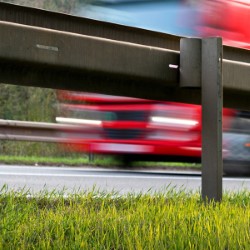Calendar Icon
Jul 26, 2017
![]() RSS
Submit a Story
RSS
Submit a Story

RELATED LINKS
Taller guardrails could be coming down the road, according to a new study from the University of Nebraska-Lincoln's Midwest Roadside Safety Facility.
By nearly any yardstick – present or future, crash test or simulation – a guardrail system that protects drivers on many U.S. highways and interstates could stand to be raised from 31 to 36 inches, the study found.
The Midwest Roadside Safety Facility, which includes numerous faculty and researchers from the College of Engineering, reached the conclusion after conducting full-scale crash tests and computer simulations to determine the maximum acceptable height of the Midwest Guardrail System. Developed in the early 2000s, the Midwest Guardrail System has since become a common roadside barrier across the country
Submit a Story